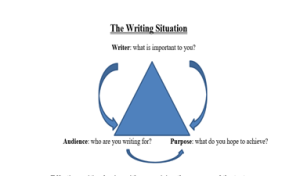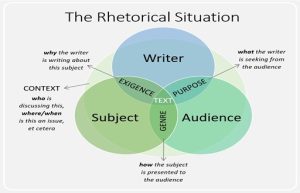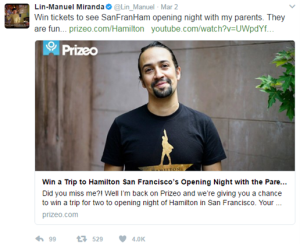5.1 The Rhetorical Situation
Rhetoric is the ancient art and science of persuasion, the study of persuasion, and the individual process of persuasion. Unfortunately, in the 21st century, rhetoric tends to be talked about as something separate from everyday communication. However, all human activities are rhetorical, whether or not we are conscious of it. This is because rhetoric is about making strategic choices while communicating, whether the communication is textual, verbal, or even aural and visual. When we communicate to different types of audiences about the same topic, we make strategic decisions about what details to include or omit, what types of evidence or support to use, and so on.
Rhetoric is generally defined as the art of persuasion and argument. While thinkers and scholars have debated the merits of various rhetorical strategies over the past few thousand years, some basic principles have remained constant since the earliest Greek philosophers began studying this topic. To begin with, effective rhetoric (and therefore effective writing) begins with recognizing the purpose that you, the writer, are trying to achieve. Before you can effectively persuade your audience, you need to know what you hope to accomplish and why. Then, you need to think carefully about your audience: about what they care about and what they are capable of understanding and accepting. You won’t achieve your purpose if you’re not able to adapt what you write to your audience. That may mean using a certain level of formality, using certain kinds of examples, organizing or formatting your writing in a particular way, or addressing counterarguments that you think your audience might have. These three components–the writer, the purpose, and the audience–make up what is commonly known as the rhetorical situation (or writing situation). You’ll need to think about each of these components if you want to create a unified and effective argument. If you ignore any of them, the entire argument suffers. Thinking about the rhetorical situation is most important during the planning stages of a writing project.
There are different ways to represent the rhetorical situation visually. The images below are two examples. There are similarities and differences between them, but each might help you to think through any situation in which you are being asked to write.


Both of these images emphasize the fact that writing is a social activity, produced by people in particular situations for particular goals. They can help you to understand that, because writing is highly situated and responds to specific human needs in a particular time and place, texts should be produced and interpreted with these needs and contexts in mind. As a writer, thinking carefully about the situations in which you find yourself writing can lead you to produce more meaningful texts that are appropriate for the situation and responsive to others’ needs, values, and expectations. This is true whether writing a workplace e-mail or completing a college writing assignment. As a reader, considering the rhetorical situation can help you develop a more detailed understanding of others and their texts. In short, the rhetorical situation can help writers and readers think through and determine why texts exist, what they aim to do, and how they do it in particular situations.
Here’s another way to think about the components of the rhetorical situation. Below it, you’ll find an example of how you can analyze any piece of communication by thinking about its rhetorical situation.
Writer
The writer is the individual, group, or organization who authors a text. Every writer brings a frame of reference to the rhetorical situation that affects how and what they say about a subject. Their frame of reference is influenced by their experiences, values and needs, race and ethnicity, gender and education, geography and institutional affiliations, to name just a few factors.
Audience
The audience includes the individuals the writer engages with the text. Most often there is an intended, or target, audience for the text. Audiences encounter and in some way use the text based on their own experiences, values, and needs that may or may not align with the writer’s.
Purpose
The purpose is what the writer and the text aim to do. To think rhetorically about purpose is to think both about what motivated writers to write and what the goals of their texts are. These goals may originate from a personal place, but they are shared when writers engage audiences through writing.
Exigence
The exigence refers to the perceived need for the text, an urgent imperfection a writer identifies and then responds to through writing. To think rhetorically about exigence is to think about what writers and texts respond to through writing.
Subject
The subject refers to the issue at hand, the major topics the writer, text, and audience address.
Context
The context refers to other direct and indirect social, cultural, geographic, political, and institutional factors that likely influence the writer, text, and audience in a particular situation.
Genre
The genre refers to the type of text the writer produces. Some texts are more appropriate than others in a given situation, and a writer’s successful use of genre depends on how well they meet, and sometimes challenge, the genre conventions.
Analyzing a Tweet from Lin-Manuel Miranda’s Twitter Page
Now let’s look at a sample piece of writing and think about it’s rhetorical situation. We’ll analyze a tweet to demonstrate how it relates to the various components of the rhetorical situation explained above. When conducting a rhetorical analysis, generally writers are asked to examine how a particular message is conveyed. This means looking at different aspects or parts of the media to determine the intended effect on the audience.

Tone and Audience
The term “SanFranHam” speaks to the more casual nature of Twitter and is directly addressing an audience familiar with the Hamilton musical’s updates and shows.
Additional Resources
The link to the YouTube video allows viewers to learn more about the contest while still adhering to the then 140 character limit.
Purpose
When Miranda talks about seeing Hamilton with his parents, he is building a more personal relationship with his followers as he invites them to join his family. Literally.
Composition
The center framing and natural lighting puts all focus on him, and his casual, easy half-smile is welcoming and a bit goofy, which appeals to an audience interested in learning more about him.
Wardrobe Choices
Miranda’s Hamilton shirt is a purposeful choice to advertise the show in addition to the contest.
Purpose
“Did you miss me?!” Expresses enthusiasm, but also hints that if Miranda is followed on these platforms, more contest opportunities may become available since this is not the first time a contest has been offered.
Rhetoric is everywhere and is a way to enact change in your world; however, it takes practice to recognize and use rhetoric. Study the other information in this chapter to learn more about using rhetoric as a tool in your everyday life. Remember—rhetoric can be a catalyst for change in your world and the lives of people in it, but it is up to you whether or not to harness this power.
Exercise: Analyze the Rhetorical Situations
Rhetoric is not just ancient history. Here are some great examples of modern rhetoric and persuasion at work. Study these texts and try analyzing their rhetorical situations.
Continue Reading: 5.2 Audience
